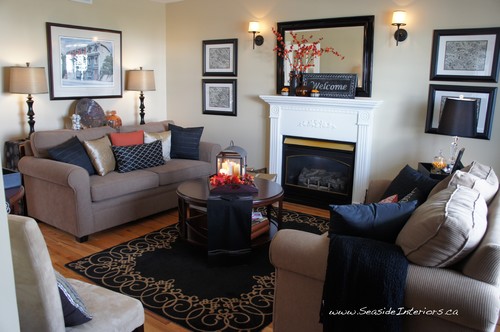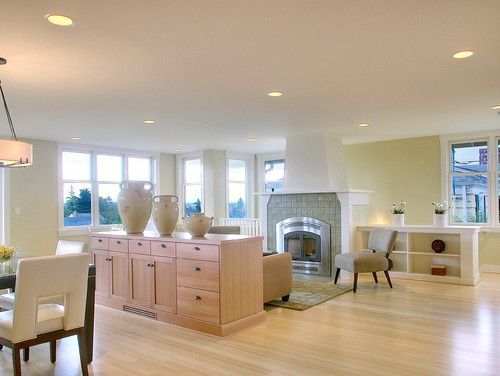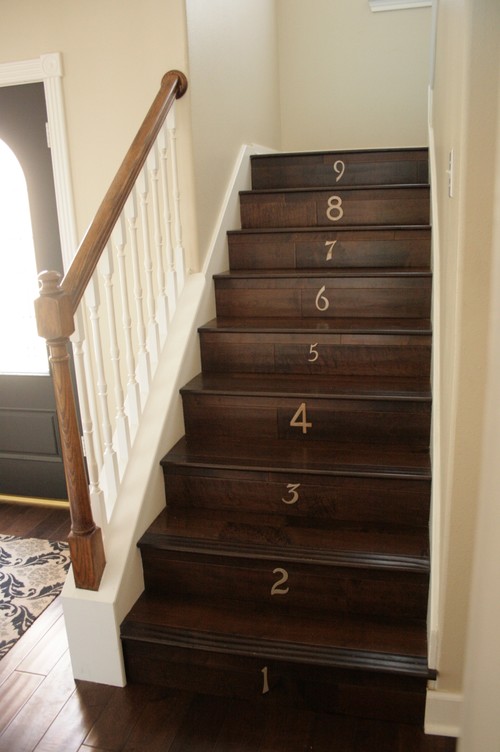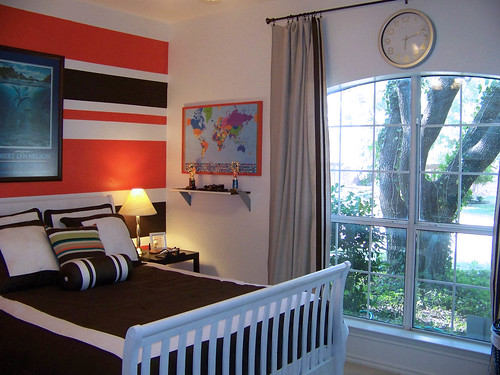Color Soiree: Pops of Magenta
Creative Decorating Ideas
 |
| BHG.com |
I can't believe Christmas is already over, can you? Our weather cooperated for travel, thankfully, and we had a great time with our families! Hope you all did as well.
 |
| BHG.com |
Use a rug to make a headboard "slipcover. Attach with clip-on drapery rings and ribbon.
 |
| Midwest Living |
 |
| Midwest Living |
Finish the edges with decorative trim and nail heads. Cover with a thin piece of glass...
 |
| Style At Home - Designer Virginia Macdonald |
Paint a whimsical chalkboard wall in your bathroom like they did in this one featured on Design Sponge. Then paint the ceiling blue, of course! (I think a mirror inside the chalkboard frame would up the functionality a bit.) Probably not for every bathroom, but I do love it...

 |
| Designer Tobi Fairley via At Home Arkansas |
 |
| Country Living Photo Susie Cushner |
 |
| Womens Day Photo Michael Partenio |
I've seen the numbered stairs idea before with painted steps, but I really like this idea of adding mismatched metal numbers with the rich stained wood...
Creative Decorating DIY Ideas and a Winner!
I really liked decorating editor Rebecca Robertson's eclectic modern room! Great use of color and pattern and awesome DIY ideas...

Have a great day...
How high do you hang your curtains, and what about that space?
- Higher is better. It adds height to the room and more presence to the windows. I also like them hung off to the side with the inside edge of the panels just covering the inside of the window casings because it makes the windows appear wider and allows more light in.
- Southern living - "Hang your drapes high. To create the illusion of a larger room, hang your drapery rod just below the ceiling rather than right above the window frame. A higher rod draws the eye up and allows more light to come in. If the ready-made curtains you love aren’t long enough, add a simple band of fabric in your accent color for a custom look that costs a lot less."
- From Canadian House and Home's How to Hang Curtains - "For standard drapes that hang on either side of a window creating a frame, the typical height at which to install the drapery rod is halfway between the top of the window and the ceiling. This applies if there are more than 12 inches between the window trim and ceiling. For a cathedral ceiling, try to leave approximately 4 to 6 inches above the window trim as a guideline. If your ceiling is low, consider installing the rod as close to the ceiling or crown moulding as possible. In a small room, hanging drapery panels as high as possible will give the illusion of extra height."
Many times hanging the treatments higher is not that much of a stretch because the window is fairly close to the ceiling.
 myhomeideas
myhomeideasBut other times there is a space between the top of the window and the rod. Almost every time I would suggest curtains be hung higher than the window (without a top treatment) when the ceiling wasn't in close proximity, I would get the question "but what about that space?"

 |
| Colour Confidential |
A cornice board is an option everyone is probably familiar with...
 |
| Colour Confidential |



GCI Design used artwork...

What's behind the sofa?
 womans day
womans day Don't worry, this isn't a post about when the last time was that everyone cleaned behind their sofa! :-) We're just looking at some behind-the-sofa decorating inspiration.
In many living rooms, the sofa is against a wall and there just isn't space or really any need to have anything behind it.
 myhomeideas.com
myhomeideas.com But sometimes even when your sofa is against the wall, a slim sofa table can still be an option. It provides a space for lamps when there isn't room for end tables or floor lamps, helps with accessorizing the wall and, in a larger room, allows you to move the sofa in for more intimate seating without leaving an empty space behind it.

The above idea can also be used to fill in the space behind a sofa when you're angling it in a corner. A folding screen would be another option.
They've used the same idea below of filling the extra space with a console table when trying to make the seating more intimate but, in this case, I believe there's a walkway between the table and the wall. The clever placement of the art keeps your eye from moving beyond the seating area.

Remember this CR Laine image from this post? An out-of-the-box option...

An open floor plan brings another set of options. I was taught to avoid placing a sofa in a way that you would be staring at the back of it, if possible. Once I started decorating real-life rooms, I quickly realized that many times, especially in an open floor plan, it's just not possible.

However, there are ways that you can divert attention from the sofa back...
This is actually the image that inspired me to do this post. A nicely accessorized table behind the sofa in an open space can create a room divider of sorts and a cozy, more intimate feeling to the spaces on either side of it.
Having two chairs on either side of a console table is a nice option, especially if the adjoining open space is a dining room. Extra dining chairs can be placed on either side and then pulled into the dining area as needed. The addition of a lower shelf on this table allows more space for accessorizing or open storage for items that you don't mind having on display, such as books, and further distracts from the sofa back. As with some of the other images we've seen, this is also a nice spot for lamps, which are not only functional but give another level of interest, color and texture to the room.
 House Beautiful photo Julian Wass
House Beautiful photo Julian Wass
I like Amanda Nisbet's take on what to put behind the sofa. Going with an oval table versus the standard rectangular console and using two ottomans on either side instead of chairs.
In this open space, they've used a console table as a divider of sorts with a walkway on either side. An interesting idea.
Another interesting idea. An accessorized bench behind the sofa...
In smaller open-plan spaces that need to be multi-functional, the back of the sofa can be used as a divider wall of sorts to create another space such as:
an office...
or a dining area/work surface. In this case, they've used a bench that can be easily tucked under for the "traffic side" of the table.
 myhomeideas.com Robbie Caponetto
myhomeideas.com Robbie Caponetto
Here are a couple of more permanent solutions... house and home Photo Angus McRitchie
house and home Photo Angus McRitchie

__________________________________________________
I've also seen decorative items like trunks, etc. used behind the sofa. I think it can work as long as you really pay attention to scale. Larger items and fewer of them is best or they can look lost against the back of the sofa and create a cluttered look rather than a design statement.
__________________________________________________
What's behind my sofa in my open plan home? Nothing. In fact, you can see the back of my sofa when you come in the front door because that's the best furniture placement, in my opinion, for the living room and there's no space behind to put anything to soften the transition. The sofa has a reverse camel back which creates some interest and there's plenty of room to walk around it, so you don't get the feeling that it's trying to block you from coming into the room. I'm absolutely okay with it.
I do think I might try this little trick though. A well placed throw to distract the eye...
 House Beautiful
House Beautiful What's behind your sofa? Any creative ideas?
Don't forget to enter the GIVEAWAY!
























